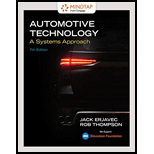
Mindtap For Erjavec/thompson's Automotive Technology: A Systems Approach, 4 Terms Printed Access Card (mindtap Course List)
7th Edition
ISBN: 9781337794381
Author: Jack Erjavec, Rob Thompson
Publisher: Cengage Learning
expand_more
expand_more
format_list_bulleted
Concept explainers
Question
Chapter 49, Problem 9SA
To determine
The term tracking as it applies to vehicle handling.
Expert Solution & Answer
Trending nowThis is a popular solution!

Students have asked these similar questions
(b): Let us first consider controlling the orbit of deputy spacecraft to rendezvous with chief spacecraft.
Define x = [r] and x = x = R to represent the deputy orbital state and its target (= chief
orbit) in Cartesian coordinates, respectively. The control input is thruster acceleration, u € R³, in the
ECI frame. Denote the relative state by dx = x-x. Table 2 summarize the initial orbital elements.
Table 2: Keplerian orbital elements at epoch (t = 0) for deputy and chief about Earth (ECI frame)
Orbital element
Deputy
Unit
Chief
semi-major axis
ad =
11500
ac 10000 km
eccentricity
inclination
ed = 0.15
id=35
ee = 0.3
i = 50
degree
right ascension of ascending node d = 50
Ως = 50
degree
argument of periapsis
true anomaly at epoch
Wd
Vd= 0
=
40
We =
40
degree
Ve=0
degree
(b.1): Derive the error dynamics of our system in ECI frame under the influence of u.
(b.2): Consider a candidate Lyapunov function V = ½dr¹ K₁dr+dv₁dv, where K₁ = K, and K, > 0.
Discuss the positive definiteness of V, and…
One image show problem c.1 and c.2 that I need help with. The second image shows the lyapunov function and its derivative but it is NOT the same function that is given in problem. I have attached that image as an example.
This is a tilt and rotation question. Here are notes attached for reference.
Chapter 49 Solutions
Mindtap For Erjavec/thompson's Automotive Technology: A Systems Approach, 4 Terms Printed Access Card (mindtap Course List)
Ch. 49 - Define camber.Ch. 49 - What tire wear pattern will result from excessive...Ch. 49 - What can be caused by excessive negative caster?Ch. 49 - Describe the difference between toe-in and...Ch. 49 - Describe thrust angle and why it is important foi...Ch. 49 - What can cause incorrect toe-out-on-turns?Ch. 49 - In what direction must the bottom of a tire and...Ch. 49 - What is scrub radius and why is it important?Ch. 49 - Prob. 9SACh. 49 - Describe how caster adjustment may be used to com...
Ch. 49 - A 3-degree difference in the SAI angle on each...Ch. 49 - Prob. 12SACh. 49 - Which of the following is a good definition of...Ch. 49 - Unequal SAI angles on the left and right sides of...Ch. 49 - While driving straight, a FWD car pulls to the...Ch. 49 - Technician A says that negative caster provides...Ch. 49 - Technician A says that the purpose of the steering...Ch. 49 - Technician A says that the presence of a thrust...Ch. 49 - Technician A says that camber changes as the...Ch. 49 - Technician A says that caster can be adjusted on...Ch. 49 - Technician A says that on FWD vehicles, the front...Ch. 49 - Technician A says that if caster at both wheels is...Ch. 49 - While discussing front-wheel caster: Technician A...Ch. 49 - While performing a prealignment inspection:...Ch. 49 - While performing a prealignment inspection:...
Knowledge Booster
Learn more about
Need a deep-dive on the concept behind this application? Look no further. Learn more about this topic, mechanical-engineering and related others by exploring similar questions and additional content below.Similar questions
- The crate of mass m is supported on a cart of negligible mass as shown in (Figure 1). Determine the maximum force P that can be applied a distance d from the cart bottom without causing the crate to tip on the cart. Express your answer in terms of some, all, or none of the variables b, d, h, m, and the acceleration due to gravity g. P B harrow_forwardConsider a pair of pipes running in parallel, through which 1200 GPM flows, which have thefollowing features:Pipe 1: Carbon Steel, Schedule 40, 8" Diameter, 1200 GPM, Water at 44°F, Fittings:2 tees, 2 butterfly valves, 2 pressure gauges with their respective ball valves, 1 valvemotorized balloon. All valves are completely open. Length of the pipe is 6 feet. Pipe 2: consists of a carbon steel bypass pipe, schedule 40, diameter of 4",with the following accessories: 2 elbows long radius of 90° and an open globe valve.The length of the pipe is 10 feet. a) Determine the flow rate in each pipe.b) The pressure drop.arrow_forward1-ft3 of air is contained in a spring-loaded piston-cylinder device. The spring constant is 6 lbf/in, and thepiston diameter is 12 in. When no force is exerted by the spring on the piston, the state of the air is 250 psiaand 450◦F. This device is now cooled until the volume is one-third its original size. Determine the changein the specific internal energy and enthalpy of the air.arrow_forward
- This is a tilt and rotation question. Here are notes attached for reference.arrow_forwardThis is a tilt and rotation question. Here are notes attached for reference.arrow_forwardI need help with a MATLAB code. For question b.6 I have the MATLAB code shown below. How do I edit the code to answer question b.7. Please make sure the plots are reasonable. clc; clear all; % Constants mu = 398600; % Earth gravitational parameter, km^3/s^2 % Initial chief and deputy positions and velocities in ECI frame % Assume circular orbits in equatorial plane for simplicity a_c = 10000; % km a_d = 11500; % km r_c0 = [a_c; 0; 0]; v_c0 = [0; sqrt(mu/a_c); 0]; r_d0 = [a_d; 0; 0]; v_d0 = [0; sqrt(mu/a_d); 0]; % Initial relative state delta_r0 = r_d0 - r_c0; delta_v0 = v_d0 - v_c0; x0 = [delta_r0; delta_v0]; % 6x1 initial relative state % Time span tspan = [0 3600]; % 1 hour in seconds % Damping cases cases = struct( ... 'name', {'Critically damped', 'Under-damped', 'Over-damped'}, ... 'Kr', {eye(3)*2.5e-3, eye(3)*0.001, eye(3)*0.01}, ... 'P', {eye(3)*0.01, eye(3)*0.0006, eye(3)*0.02} ... ); % Simulate each case for i = 1:length(cases) Kr = cases(i).Kr; P =…arrow_forward
- Just do Questions 7, 9, 11. Here are notes attached for reference.arrow_forwardThis is a tilt and rotation question. Here are notes attached for reference.arrow_forwardThermodynamics: Mass and Energy Analysis Of Control Volumes A spring-loaded piston-cylinder device contains 1.5 kg of carbon dioxide. This system is heated from 200kPa and 25◦C to 1200 kPa and 300◦C. Determine the total heat transfer to and work produced by this system.arrow_forward
- Can you help with a code in MATLAB?arrow_forwardI need help writing a code in MATLAB. Please help me with question b.6arrow_forwardThermodynamics: Mass and Energy Analysis Of Control Volumes 1.5-kg of water that is initially at 90◦C with a quality of 5 percent occupies a spring-loaded piston-cylinder device. This device is now heated until the pressure rises to 900 kPa and the temperature is 280◦C. Determinethe total work produced during this process, in kJ.arrow_forward
arrow_back_ios
SEE MORE QUESTIONS
arrow_forward_ios
Recommended textbooks for you
 Automotive Technology: A Systems Approach (MindTa...Mechanical EngineeringISBN:9781133612315Author:Jack Erjavec, Rob ThompsonPublisher:Cengage Learning
Automotive Technology: A Systems Approach (MindTa...Mechanical EngineeringISBN:9781133612315Author:Jack Erjavec, Rob ThompsonPublisher:Cengage Learning Automotive TechnologyMechanical EngineeringISBN:9781337794213Author:ERJAVEC, Jack.Publisher:Cengage,
Automotive TechnologyMechanical EngineeringISBN:9781337794213Author:ERJAVEC, Jack.Publisher:Cengage,

Automotive Technology: A Systems Approach (MindTa...
Mechanical Engineering
ISBN:9781133612315
Author:Jack Erjavec, Rob Thompson
Publisher:Cengage Learning

Automotive Technology
Mechanical Engineering
ISBN:9781337794213
Author:ERJAVEC, Jack.
Publisher:Cengage,